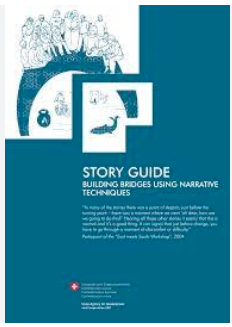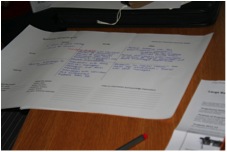On Wednesday I had the pleasure of meeting and listening to Karen McFarlane who is Head of Profession, Knowledge & Information Management (KIM) for the UK Government’s Civil Service. I’d been invited as a guest by NetIKX as a precursor to a talk I am giving there early in 2014. And with due permission (Karen’s ‘day job’ is quite sensitive) I posted a few Tweets on what I heard which you can find on their twitter feed for the event #netikx63.
The Knowledge Council – setting frameworks and strategy for the KIM Profession
Karen outlined the work that has taken place over 18 months at the Knowledge Council to develop a framework and a new Government Knowledge & Information Strategy (GKIS). Her aim is to ensure people in KIM roles have KIM qualifications with good succession planning. A profession (currently 1,000 people across government are considered KIM professionals) that will attract and maintain talent and create an environment where KIM civil servants can move across roles equipped to do so.
These comments (which I am paraphrasing) stood out:
There is a real concern about loss of knowledge when people leave which is why a lot of effort has gone into building a knowledge harvesting toolkit for the KIM community….
One of the techniques is a Mastermind Chair; another, getting people to ask ‘what questions do you wish you’d asked…Try and identify the critical people… many departments use social media to share knowledge…
...True tacit knowledge can’t be passed on when people leave, you need a strategy to ensure you don’t get to that point…
Some organisations are now making use of Alumni networks to keep access to people who’ve left…
And finally… Department of Work and Pensions (DWP) and Her Majesty’s Revenue and Customs (HMRC) are now sharing stories on their intranet…
an accredited career pathway
Karen painted a backdrop wherein the topic of knowledge & information management is higher up the agenda in government than it has been for more than two decades. All of which is really positive as is the work being done with external bodies such as CILIP on accreditation and training and career pathways for KIM professionals in government. Its impressive progress which the soon to be released GKIS will place into context.
This brings me back to the ‘capturing and exploiting corporate knowledge’ pilot we* have been running for HMRC’s businesses under the supervision of their KIM professionals.
HMRC’s Pilot Programme: Setting Up and Capturing: Modules 2 & 3
My previous postings looked at why HMRC had set up the pilot programme, what critical knowledge is, how to identify it and why it is important. Modules 2 & 3 of the programme focused on:
| Setting up |
how to identify and approach the knowledge holders & networks |
how to design a knowledge capturing approach |
| Capturing |
develop an understanding of different capture techniques |
benchmark against existing approaches |
‘Our’ delegates recognised:
- not everyone who changes jobs or leaves has critical knowledge whose loss will severely damage the organisation. Its important to be proactive to identify where it resides and with whom – the knowledge holder.
- everyone is different. Each person who partially retires will feel differently about what they want to give back. Some people might initiate. Approach each person differently in order to find out how they feel about knowledge capture.
In Module 2 we looked at the setting, preparation and clarity of purpose which are all key to successful capturing of knowledge. A key task is to think seriously about how a request for time with a knowledge holder is likely to be received.

A typical Knowledge Holder?
Profiling and Archetype Mapping are used extensively in design, it is even more important when dealing with intangibles to have identified and acknowledged likely preferences of the person you are approaching?

A large exhibit in Asia that sought to identify major events in the life of an institution. Passers by were asked to note on a timeline events that were of interest to them. This helped to target key players for future interviews and the subject areas to be covered.
Focusing on the individual is just one aspect of knowledge capture & retention: it’s vital to focus in addition on decisions, events and processes (documented as well as practiced) to see what knowledge is called upon in the first place and from where and then what is produced during the process.
Another key aspect is to create the right environment for the discussion/interview/observational session. This is especially important when the intervention is to be recorded or a large response is sought.
The delegates spent time thinking about the right form of consent, how they might craft the invitation to participate and the mechanism they’d use to capture material.
Module 3 was very much about trying out. The delegates looked at:
- Sketchbooks
- Interviewing
- Recording
- Group Elicitation
- Reverse thinking
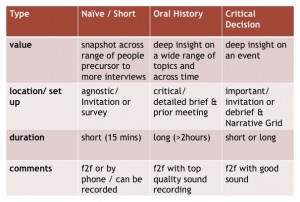 They discussed a variety of approaches to interviewing, comparing those with the checklist already developed for HMRC.
They discussed a variety of approaches to interviewing, comparing those with the checklist already developed for HMRC.
And they worked on interviewing (and listening) skills comparing and contrasting experiences.
As part of the benchmarking exercise we encouraged delegates to look at the 47 step knowledge capture process as articulated in Professor Nicholas Milton’s book Knowledge Acquisition in Practice which was very successfully adapted by John Day, at Sellafield that in itself drew on work done by Shell on its Retention of Critical Knowledge (ROCK) programme.
As in the previous modules offsite work involved listening to audios developed exclusively for this programme including a clip on Baton Passing, a technique used by the British Council adapted for their use by Professor Victor Newman.
importance and danger of Knowledge Harvesting
To return to the beginning. The Knowledge Council’s focus on equipping KIM Professionals with tools and techniques in Knowledge Harvesting is admirable. Yet I felt there is a missing skill from the training ‘suite’ shown by Karen McFarlane at the NetIKX meeting, namely that of facilitation which for me is critical.
If knowledge harvesting (what I might call knowledge capture and retention) is to become an ingrained ‘way of working’ across government then people in the business need to be equipped with those skills as well. KIM professionals must have the skills to facilitate others in Knowledge Harvesting not just conduct them.
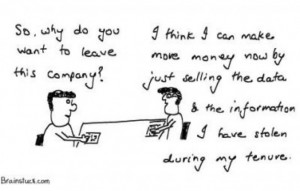 The alternative scenario is that the KIM professional gets called in to do a last minute ‘tell us what you know’ knowledge harvesting session with a prominent person and the resultant ‘pearls of wisdom’ are placed on a database that few look at or listen to.
The alternative scenario is that the KIM professional gets called in to do a last minute ‘tell us what you know’ knowledge harvesting session with a prominent person and the resultant ‘pearls of wisdom’ are placed on a database that few look at or listen to.
*Sparknow and Knowledge et al worked in partnership to deliver this programme.
In writing this book, we want to catch the excitement of the arrival of this ‘new kitchen’ and to demonstrate how the arrival of the ISO Knowledge Management System Standard (ISO 30401) provides so much more than a moment to certify a level of consistency in practice.
 Despite all the uncertainty, Brexit is proving less of a challenge as there is a move from vendors towards the type of quality service we are offering. A key statistic for us is “Property Views” online and it’s great to be able to report we are currently #1 in our region.
Despite all the uncertainty, Brexit is proving less of a challenge as there is a move from vendors towards the type of quality service we are offering. A key statistic for us is “Property Views” online and it’s great to be able to report we are currently #1 in our region.
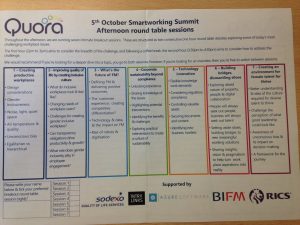 The afternoon comprised a series of breakout sessions. I went for the “Creating productive workplaces” session facilitated by John Blackwell, Quora’s founder and CEO.
The afternoon comprised a series of breakout sessions. I went for the “Creating productive workplaces” session facilitated by John Blackwell, Quora’s founder and CEO.
 their working practices and environment. One metric they are using: reduce occupancy levels (from 100% usage of the office by their staff to the mid 70’s).
their working practices and environment. One metric they are using: reduce occupancy levels (from 100% usage of the office by their staff to the mid 70’s).